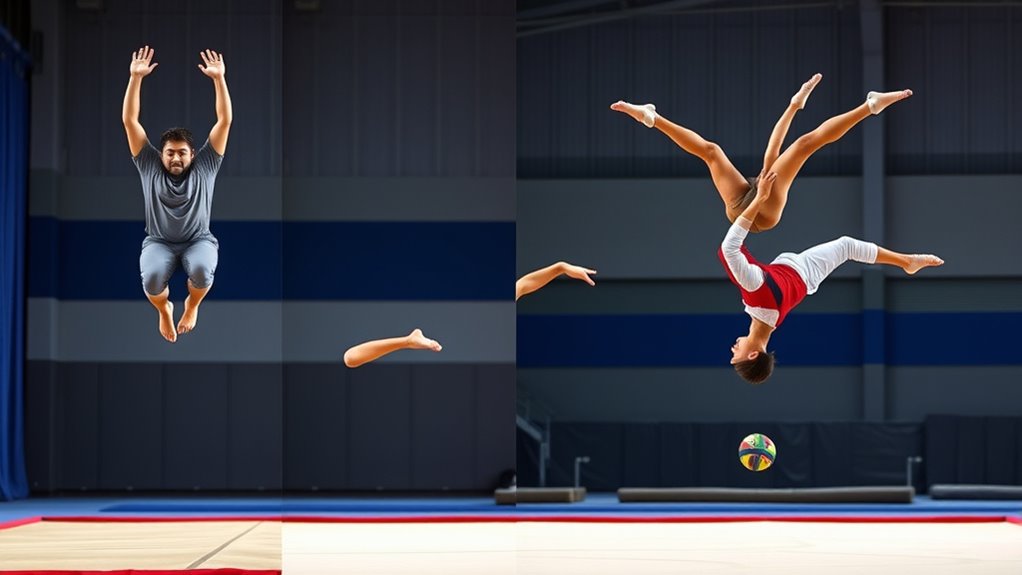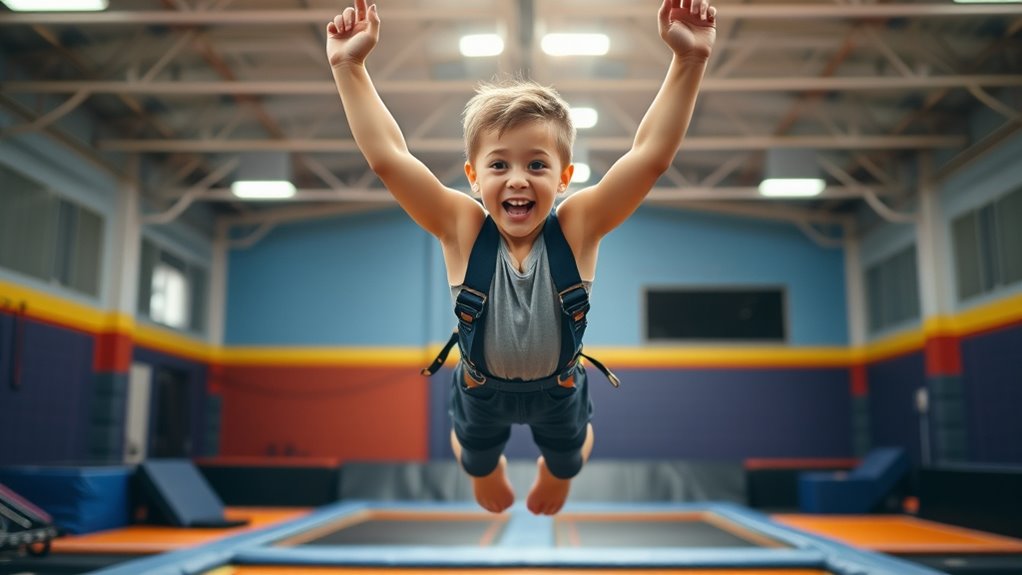To progress from beginner to backflip, start by building a strong foundation with core and limb exercises like planks and squats. Practice safety skills such as proper landing and spotter use. Focus on mastering basic jumps and aerial awareness before gradually moving to assisted flips and backhandsprings. Confidence comes from consistent practice, mental visualization, and patience. Keep progressing step-by-step to minimize risk—if you keep pushing forward, you’ll discover the key techniques along the way.
Key Takeaways
- Master foundational strength and basic movements like jumps, rolls, and balance exercises before progressing to more advanced skills.
- Break down the backflip into manageable steps, practicing each phase with proper technique and safety precautions.
- Incorporate spatial awareness, coordination, and core exercises to build necessary physical and mental readiness.
- Use visualization, positive self-talk, and mental routines to boost confidence and overcome fear incrementally.
- Progress gradually, ensuring consistent practice, patience, and emphasis on safety to build both physical ability and mental resilience.

Are you ready to see real progress in your fitness journey? Starting on a progressive training plan from beginner to backflip is an exciting challenge, but it requires careful planning and dedication. The first step is understanding that safety precautions are essential every step of the way. Before attempting any advanced moves, you should confirm your training environment is safe—use a cushioned mat, clear the area of obstacles, and have a spotter if possible. Wearing appropriate clothing and footwear also helps prevent injuries. It’s imperative not to rush through the stages; mastering foundational strength and technique first lays the groundwork for safer progression. Always listen to your body—pushing through pain can lead to setbacks or serious injuries. If something doesn’t feel right, take a step back, reassess, and seek guidance from a coach or experienced trainer.
Mental preparation is just as significant as physical readiness when working toward a backflip. Building confidence starts with visualizing success and breaking down the movement into manageable steps. Focus on positive self-talk, and don’t let fear hold you back. Instead, approach each new skill with patience and a growth mindset. Confidence grows when you see progress, so celebrate small victories along the way. Incorporate mental routines like breathing exercises or mindfulness to stay calm and focused during practice. Overcoming mental barriers is often the biggest hurdle; reminding yourself of your training, progress, and safety precautions keeps anxiety at bay. Practice visualization techniques to imagine yourself executing the move smoothly, which can boost your belief in your abilities and reduce hesitation. Additionally, understanding the importance of progression in training helps ensure you develop the necessary skills safely and effectively.
As you advance, be sure to integrate proper warm-ups and cool-down routines to prevent injuries and aid recovery. Strengthening your core, legs, and upper body will make the move more manageable, so include exercises like planks, squats, and shoulder rolls. Consistency is key—practice regularly but avoid overtraining, which can lead to burnout or injury. Incorporate drills that build your spatial awareness, balance, and coordination, all essential for executing flips safely. Patience and perseverance are your best allies; each session builds on the last, gradually increasing your confidence and skill level. Remember, progressing from a beginner to a backflip isn’t just about physical ability—it’s about mental resilience, safety, and steady effort. Keep your focus, stay safe, and trust in your training process. Before long, you’ll be flipping with confidence, turning your aspirations into reality.
Frequently Asked Questions
How Long Does It Typically Take to Master a Backflip?
Mastering a backflip varies for everyone, but it usually takes several months of dedicated training. You should focus on training mental strength, building confidence, and practicing safety measures like proper spotting and foam pits. Consistency is key, and listening to your body helps prevent injuries. With patience and proper guidance, you’ll progress steadily and eventually land a backflip, but don’t rush—safety always comes first.
What Injuries Are Most Common During Training?
Think of training as a tightrope walk; one misstep can lead to injury. The most common injuries are sprains, strains, and sometimes fractures if safety isn’t emphasized. To prevent setbacks, focus on injury prevention by wearing proper safety gear like wrist guards and mats. Always warm up, listen to your body, and progress gradually. Staying cautious ensures your journey to mastering flips stays safe and injury-free.
Do I Need Special Equipment or a Gym?
You don’t necessarily need special equipment or gym access for your training. Focus on having proper training gear like mats, wrist guards, and comfortable clothing to stay safe and comfortable. While a gym can provide a controlled environment with padded floors and supervision, many exercises can be done at home with minimal gear. Just make sure your space is safe, clear, and suitable for practicing your moves safely.
Can I Learn Backflips Without a Coach?
You can learn backflips without a coach, but it’s risky. Martial arts and gymnastics training often emphasize proper technique and safety, which a coach provides. If you’re determined, start with basic conditioning and groundwork, then practice in a safe environment with mats. Watching tutorials can help, but having a coach or experienced spotter minimizes injury risk and ensures you progress safely toward mastering backflips.
How Do I Stay Motivated Throughout the Training Process?
To stay motivated, focus on building mental resilience and setting clear goals. Remind yourself why you started and celebrate small wins along the way. Keep track of your progress, and don’t be discouraged by setbacks—they’re part of the journey. Visualize your success, stay consistent, and remember that persistence is key. With strong goal setting and mental resilience, you’ll keep pushing forward toward mastering that backflip.
Conclusion
By following this progressive training plan, you’ll steadily build strength, confidence, and skill to land that backflip. Remember, consistency is key—most beginners who stick with their practice see progress within just a few months. Did you know that over 70% of gymnasts successfully perform a backflip after six months of dedicated training? Stay committed, trust the process, and you’ll surprise yourself with what you can achieve. Your backflip is within reach!










